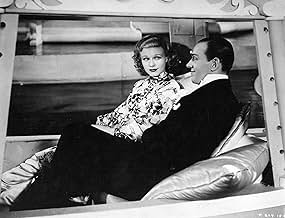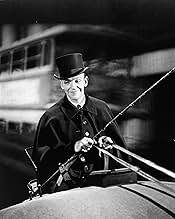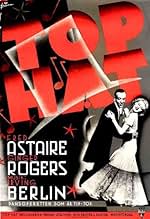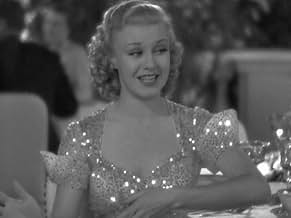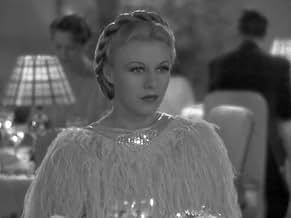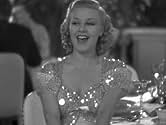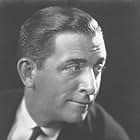An American dancer comes to Britain and falls for a model whom he initially annoyed, but she mistakes him for his goofy producer.An American dancer comes to Britain and falls for a model whom he initially annoyed, but she mistakes him for his goofy producer.An American dancer comes to Britain and falls for a model whom he initially annoyed, but she mistakes him for his goofy producer.
- Nominated for 4 Oscars
- 3 wins & 6 nominations total
Robert Adair
- London Hotel Clerk
- (uncredited)
Lucille Ball
- Flower Clerk
- (uncredited)
Tito Blasco
- Minor Role
- (uncredited)
William A. Boardway
- Club Member
- (uncredited)
Tom Brandon
- Minor Role
- (uncredited)
Roy Brent
- Minor Role
- (uncredited)
Tex Brodus
- Hotel Guest
- (uncredited)
Phyllis Coghlan
- Dancer
- (uncredited)
Gino Corrado
- Venice Hotel Manager
- (uncredited)
Tom Costello
- Minor Role
- (uncredited)
Lorinne Crawford
- Dancer
- (uncredited)
Oliver Cross
- Hotel Guest
- (uncredited)
Storyline
Did you know
- TriviaThe first time Fred Astaire and Ginger Rogers had a screenplay written specifically for them.
- GoofsWhen Dale and Beddini leave the hotel in London, it is obvious the drivers of the cabs are sitting on the left. The UK drives on the left, so the drivers should have been on the right.
- Quotes
Jerry Travers: In dealing with a girl or horse, one just lets nature take its course.
- Alternate versionsThe Lobster video edition has a few missing shots around 33 minutes.
- ConnectionsFeatured in Hollywood: The Fabulous Era (1962)
- SoundtracksAlexander's Ragtime Band
(1911) (fragment) (uncredited)
Music by Irving Berlin
In the score during the opening credits
Featured review
The stage star, Jerry Travers, disturbs a young woman's sleep by tap-dancing on the floor of a hotel room directly above hers. The young woman is Dale Tremont, a beautiful fashion model. In the course of the movie plot, by way of London, Venice and the usual snags of mistaken identity, the two youngsters flirt, dance and fall in love.
Fred Astaire was a huge Broadway star and social lion long before he ever saw the inside of a film studio. A lucky pairing with Ginger Rogers (a film star in her own right) in "Flying Down To Rio" (1933) led on to a series of smash hits throughout the 1930's. "Top Hat" was the third film the couple made together, and for this one RKO Radio started getting serious, bringing in the legendary Irving Berlin to write the sparkling songs.
This picture was preceded a year earlier by "The Gay Divorcee", and is a repeat prescription of that successful formula - wealthy, elegant characters, frivolous lifestyles, light-hearted love and sumptuous dance numbers. It is not merely the storyline of 'Divorcee' that is repeated here - alongside Fred and Ginger, several of the cast members reappear. Edward Everett Horton was the lawyer Egbert in the earlier film, and here he is Horace the impresario, but is still Fred's bumbling buddy. Eric Blore was the wisecracking waiter, now he is the sarcastic valet: Erik Rhodes plays Italian buffoons in both films - Tonetti in 'Divorcee', Beddini here. Watch out for the girl florist ... it's Lucille Ball, two years into a very long and busy showbiz career.
The film's first number is "Fancy Free", an amiable little ditty which sets the prevailing tone of easy gaiety. Fred leads into it very nicely, his speech becoming more and more rhythmic until he lifts off into song.
"It's A Lovely Day" has a great tune, witty choreography, a thunderstorm and a superb bandstand set. Yet the song everyone associates with this movie is "Top Hat, White Tie And Tails": it doesn't involve Ginger at all, but Fred makes up for that by being in breathtaking form, his performance exuding athleticism, grace, poise and assurance.
Ginger gets her turn to sing with "The Piccolino", a song designed to accord with the plot's Venetian setting. It is the weakest number in the movie, and Ginger sings it without conviction.
In order for the plot knots to unravel, it is necessary for Horace to be kept apart from his wife Madge for 24 hours, even though they haven't met for weeks and they are staying in the same hotel. This is highly artificial, but such flaws are rendered negligible by the sweeping climax of "Cheek To Cheek", the splendid finale in which Fred and Ginger get to dance as lovers.
Verdict - Immortal stylish music and dance.
Fred Astaire was a huge Broadway star and social lion long before he ever saw the inside of a film studio. A lucky pairing with Ginger Rogers (a film star in her own right) in "Flying Down To Rio" (1933) led on to a series of smash hits throughout the 1930's. "Top Hat" was the third film the couple made together, and for this one RKO Radio started getting serious, bringing in the legendary Irving Berlin to write the sparkling songs.
This picture was preceded a year earlier by "The Gay Divorcee", and is a repeat prescription of that successful formula - wealthy, elegant characters, frivolous lifestyles, light-hearted love and sumptuous dance numbers. It is not merely the storyline of 'Divorcee' that is repeated here - alongside Fred and Ginger, several of the cast members reappear. Edward Everett Horton was the lawyer Egbert in the earlier film, and here he is Horace the impresario, but is still Fred's bumbling buddy. Eric Blore was the wisecracking waiter, now he is the sarcastic valet: Erik Rhodes plays Italian buffoons in both films - Tonetti in 'Divorcee', Beddini here. Watch out for the girl florist ... it's Lucille Ball, two years into a very long and busy showbiz career.
The film's first number is "Fancy Free", an amiable little ditty which sets the prevailing tone of easy gaiety. Fred leads into it very nicely, his speech becoming more and more rhythmic until he lifts off into song.
"It's A Lovely Day" has a great tune, witty choreography, a thunderstorm and a superb bandstand set. Yet the song everyone associates with this movie is "Top Hat, White Tie And Tails": it doesn't involve Ginger at all, but Fred makes up for that by being in breathtaking form, his performance exuding athleticism, grace, poise and assurance.
Ginger gets her turn to sing with "The Piccolino", a song designed to accord with the plot's Venetian setting. It is the weakest number in the movie, and Ginger sings it without conviction.
In order for the plot knots to unravel, it is necessary for Horace to be kept apart from his wife Madge for 24 hours, even though they haven't met for weeks and they are staying in the same hotel. This is highly artificial, but such flaws are rendered negligible by the sweeping climax of "Cheek To Cheek", the splendid finale in which Fred and Ginger get to dance as lovers.
Verdict - Immortal stylish music and dance.
- How long is Top Hat?Powered by Alexa
Details
- Release date
- Country of origin
- Languages
- Also known as
- The World by the Tail
- Filming locations
- Production company
- See more company credits at IMDbPro
Box office
- Budget
- $609,000 (estimated)
- Gross worldwide
- $13,592
- Runtime1 hour 41 minutes
- Color
- Aspect ratio
- 1.37 : 1
Contribute to this page
Suggest an edit or add missing content



